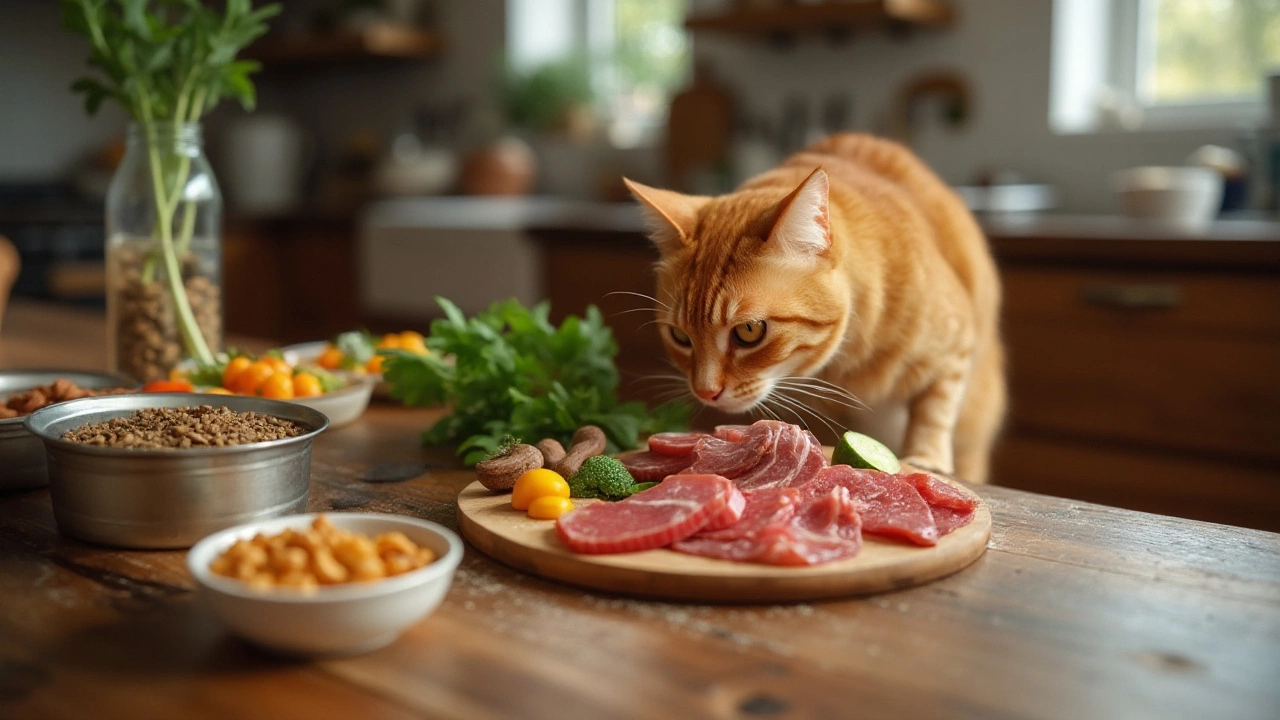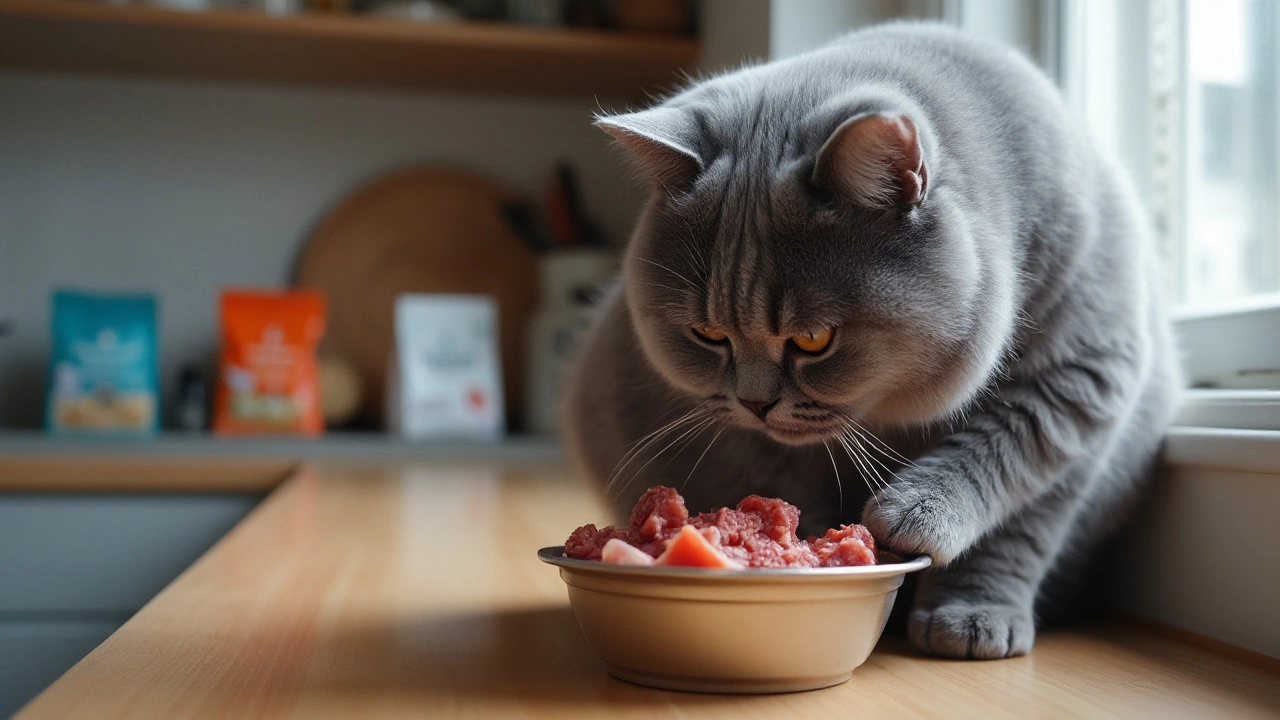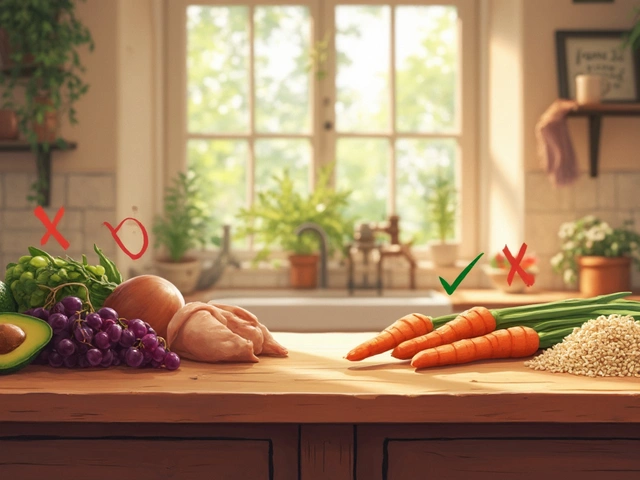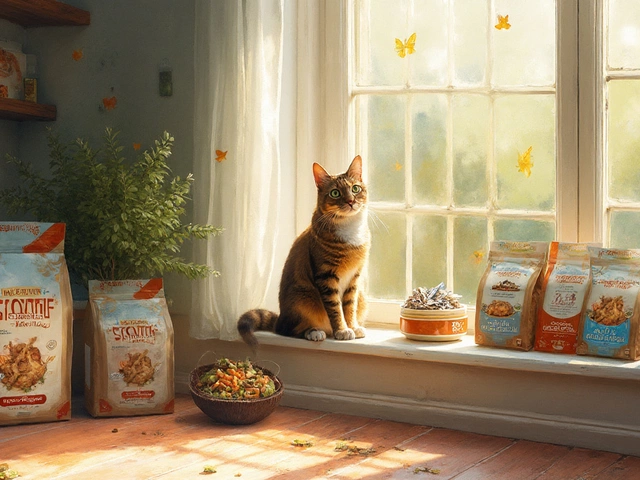Feeding your cat can seem daunting with the plethora of options available. Knowing what constitutes a healthy diet for felines can ease your choices and promote your pet's well-being. In essence, cats thrive on a protein-rich diet, and understanding their specific needs is key.
In this article, you'll discover the nuances of cat dietary requirements and explore different food types, both wet and dry. We'll navigate the often confusing world of cat food labels, ensuring you can make informed decisions when shopping for your furry friend.
Moreover, you'll gain insight into debunking common myths and learn how to choose the right food tailored to your cat's unique needs, setting them on a path to a long, happy life. Let's dive into the world of feline nutrition and find the best way to keep those whiskers healthy.
- Understanding Feline Dietary Needs
- Types of Cat Food: Wet vs. Dry
- Navigating Cat Food Labels
- Protein: The Cornerstone of a Cat’s Diet
- Common Cat Food Myths Debunked
- Choosing the Right Food for Your Cat
Understanding Feline Dietary Needs
In the world of pet ownership, understanding your cat’s dietary needs is an act of love and responsibility. Cats are obligate carnivores, meaning that their physiology relies heavily on nutrients found in animal flesh. Unlike humans or dogs, felines have a high protein requirement and a limited ability to digest carbohydrates. This unique dietary requirement is due to their evolutionary path as hunters, thriving in the wild by consuming prey that provided them with essential nutrients. They rely heavily on amino acids like taurine and arginine, which are critical for maintaining their heart health, vision, and immune system. Inadequate intake of these can lead to significant health issues, emphasizing the necessity to pay attention to their nutritional intake.
The key to a balanced diet for a cat lies in recognizing the importance of moisture-rich food. Cats have evolved to consume water primarily through the prey they eat, which means a diet lacking in moisture can result in chronic dehydration. This is where canned or wet cat food plays a critical role in their diet. Despite popular belief, providing solely dry kibble can lead to kidney problems and urinary tract infections due to insufficient water content. According to Dr. Jane Brunt, Executive Director of the CATalyst Council, "A diet that's high in moisture content is likely to be closer to what nature intended for our feline companions, supporting their overall health and reducing the risk of common illnesses."
When planning your cat’s meals, it’s important to incorporate a spectrum of nutrients. Proteins should form the foundation of your pet’s diet, ideally constituting a significant part of their caloric intake. Cats efficiently process fats as their main energy source, unlike carbohydrates which should be limited due to their tendency to lead to obesity and diabetes in cats. Meanwhile, vitamins and minerals from organ meats or specific supplements ensure the fulfillment of other dietary requirements, though these should be administered based on veterinary advice. Tailoring your cat's diet with these components in mind helps ensure they remain healthy and active.
To further comprehend what your cat needs, observing their behavior and physical condition can provide clues about their dietary health. Energetic play, a shiny coat, and a healthy weight are indicators of a well-balanced diet. If your cat is lethargic or shows repeated signs of digestive distress, it might be time to assess their food intake and adjust it as necessary. Engage with your veterinarian to evaluate any significant changes you notice, ensuring your cat's diet meets their specific needs at different life stages. By staying attuned to their unique dietary requirements, you pave the way for a thriving and vibrant life for your furry companion.
Types of Cat Food: Wet vs. Dry
When it comes to feeding your beloved feline, one of the most debated topics is choosing between wet cat food and dry cat food. Each option presents its own set of benefits and potential drawbacks, leaving cat owners in a quandary over the best choice for their pets. The decision often hinges on factors such as nutritional value, palatability, convenience, and cost.
Wet food, typically sold in cans or pouches, is often touted for its high moisture content, a crucial aspect for cats as they are known to have a low thirst drive. This increased hydration can be particularly beneficial in preventing urinary tract issues, common among felines. Additionally, the enticing aroma and texture of wet food may appeal more to fussy eaters, encouraging them to consume their essential nutrients. On the downside, wet food can be more costly over time and often requires refrigeration once opened, which may not be convenient for all pet owners.
Dry food, or kibble, presents a distinct set of advantages. It's generally more affordable and can be left out for extended periods without spoiling, making it a convenient option for busy pet parents. Many cats enjoy the crunch of kibble, which can help with dental health by reducing plaque and tartar buildup. However, dry food lacks the moisture needed for optimal hydration and may not be suitable for cats prone to kidney or urinary issues. Ensuring your cat drinks enough water when primarily feeding dry food is essential for maintaining health.
According to Dr. Jennifer Coates, a veterinary advisor, "There's no one-size-fits-all answer when deciding between wet and dry cat food. The key is to pay attention to your cat's unique health needs, preferences, and lifestyle." Striking a balance between the two varieties is an approach many owners take. Providing a combination of wet and dry food can offer the hydration and flavor of canned meals while retaining the convenience of kibble.
Some studies suggest that a mix of both types can provide a better balance of nutrition, catering to a cat's natural hunting instincts by mimicking the variety found in prey. Always ensure that the chosen products fulfill all the necessary dietary requirements for your feline friend. As noted in a comparative study, cats benefit most from a diet enriched with proteins, as they are obligate carnivores.
Here's a quick view of certain aspects of cat foods:
| Aspect | Wet Food | Dry Food |
|---|---|---|
| Hydration | High | Low |
| Cost | Higher | Lower |
| Convenience | Moderate | High |
| Dental Health | Low | High |
To wrap up, whether you lean towards wet cat food or dry cat food, understanding your cat's individual needs and consulting with a veterinarian can lead you to the ideal feeding strategy for a healthier, happier feline companion. Combining both types of food or choosing a specific one should reflect both your and your cat's lifestyle needs and preferences.

Navigating Cat Food Labels
Walking down the pet food aisle can feel like an expedition through an unknown territory. With colorful packaging and bold claims, deciphering cat food labels can be confusing for any pet owner. The first step to clarity is understanding that labels are a mandatory document summarizing what's inside each can or bag. By law, cat food labels must list all ingredients, usually in descending order by weight, so the first few items you see are crucial for determining quality. Keywords like 'chicken', 'beef', or 'fish' should appear prominently if you're leaning towards high-protein options for your feline friend.
Feline nutrition means paying close attention to both macronutrients and micronutrients. Labels should highlight essential elements such as taurine, an amino acid crucial to a cat's heart and eye health. Unfortunately, decoding nutritional adequacy can often be overlooked. Shoppers should lookout for assurances like "complete and balanced" nutrition, signifying that the food meets standards set by the Association of American Feed Control Officials (AAFCO). This provides reassurance that your cat's dietary needs are being effectively met, whether you're buying dry kibble or wet cat food.
"Reading a pet food label should not be an exercise in frustration. You are the voice for your pet, so make sure that voice is informed and bold," says feline nutrition expert Dr. Jane Bicks.
It's also important to discern marketing jargon from scientific fact. Terms like "natural" or "premium" sound appealing but lack formal definitions under pet food regulations. Rather than focusing on these often misleading expressions, deep dive into the specific ingredient lists and nutritional breakdown tables. This information unveils far more pertinent details about what's actually nourishing your cat's diet.
Understanding Guaranteed Analysis
Equally significant in label evaluation is the "Guaranteed Analysis" section, revealing the minimum percentages of protein and fat and maximum percentages of fiber and moisture. While the Guaranteed Analysis provides an overall snapshot, factors such as digestibility and caloric density frequently go unreported. Comparing these data points is best done through a dry matter basis, which can be calculated or consulted with your vet to avoid unnecessary guesswork. Aiming for cat food options that reflect an optimal balance between proteins, fats, and carbohydrates will support a healthy and energetic lifestyle for your cat.Navigating cat food labels means being an informed buyer with a keen eye toward both promises and scientific elements present on packaging. As you make choices for your feline companions, understand that learning more about these quirks and details will yield dividends in your cat's health and longevity. So next time you pick up a can or bag, remember—those words and numbers on the side are not just mere suggestions, they’re insights into what will fuel your beloved furry friend.
Protein: The Cornerstone of a Cat’s Diet
Cats, our mesmerizing and meticulous companions, have dietary needs that are quite different from ours. Unlike us omnivores, felines are obligate carnivores. This means that their diet must be rich in proteins in order to sustain their muscle mass, support enzymatic functions, and maintain their overall health. But why is protein so important for cats, and how can you ensure they are receiving enough?
Each time your cat gracefully pounces with agility or climbs deftly onto an intimidatingly high ledge, that is their protein-rich diet at work. Proteins serve as building blocks for their muscles, tendons, and fur. Nearly every cellular function relies on proteins. Amino acids, the components of proteins, are essential since cats cannot naturally synthesize some of the critical ones, especially taurine, arginine, and methionine. Without adequate taurine, for instance, a cat might face vision impairment, heart issues, or even dental troubles.
Providing quality sources of protein is paramount. Consider the popularity and reliability of poultry, beef, and fish-based cat foods in today’s market. These not only offer a rich source of feline nutrition but also are often the flavors that cats adore. Moreover, it's wise to opt for foods where the protein source is listed as the first ingredient. This ensures the product isn't laden with inadequate fillers which cats have a challenging time digesting.
"Cats tend to have a higher protein requirement than dogs, and can suffer from health problems if their diet does not provide enough protein," Dr. Ann Hohenhaus, DVM, has noted in her discussions about feline dietary needs.
It's worth noting that the age, activity level, and health of your cat can influence the amount of protein they require. A young, active kitten will have vastly different needs compared to a more sedentary senior cat. Therefore, cat owners should take time to inspect the nutrient profiles on food packaging, ever mindful of the essential nature of feeding cats right.
| Nutrient | Percentage in Diet |
|---|---|
| Protein | 30%-40% |
| Fat | 15%-20% |
| Carbohydrates | Less than 10% |
Beware of feeding your cats a diet that mimics current human trends, like vegetarian or vegan eating. Such approaches can be detrimental. Cats require other nutrients and vitamins such as vitamin A, niacin, and arachidonic acid, primarily found in animal tissues. Before making any changes to your cat’s diet, consulting with your vet is always a prudent step.
By emphasizing a protein-rich diet that respects the evolutionary makeup of your beloved pet, you’ll ensure they enjoy a life that is healthy, vigorous, and brimming with the curiosity that endears us to our feline friends. Remember, when it comes to cat food, knowing your cat means knowing their needs.

Common Cat Food Myths Debunked
The world of cat food is rife with myths that can often mislead pet parents. Understanding what’s fact and what’s fiction is crucial in providing your cat with a diet that supports their health and happiness. One widespread myth is that cats can thrive on a vegetarian diet. While humans may choose vegetarianism, cats are obligate carnivores. This means they need meat to survive, deriving essential nutrients like taurine, arachidonic acid, and vitamin A from animal sources. Without these, cats can experience severe health issues, including heart diseases and early blindness.
Another common misconception is that wet food is inherently better than dry food, or vice versa. Both wet and dry cat food have pros and cons. Wet food, with its high moisture content, can be beneficial for cats with urinary tract problems or those requiring higher hydration. Dry food, on the other hand, can aid in dental health by reducing tartar buildup and is often more convenient for cat parents to store. The key is to find a balance that suits your cat’s unique health needs and lifestyle. Some cats may prefer the taste and texture of wet food, while others thrive on a mixed diet.
It’s also mistakenly believed that grains are unsuitable for cats. While it is true that cats don’t require grains, not all cats are grain-sensitive. Grains in moderate amounts can add valuable nutrients and fiber to a cat’s diet. The real culprit for food allergies in cats often lies within proteins from meat such as beef or fish, rather than grains themselves. Pet owners should be guided by their cat’s individual reactions to food and consult with a vet for tailored dietary advice.
"The surest way to create an allergy is to feed the same diet over a long period," says veterinarian Dr. Cindi Bosco. "Like anything, a varied and balanced diet is always best."
Many cat owners worry about by-products in their cat's meals. It’s assumed that by-products are unhealthy or useless fillers. However, the truth is that by-products can be nutritious components of animal products that humans typically don’t consume, yet are rich in essential vitamins and minerals. This often includes organs like liver or lungs. The important thing is to ensure these by-products come from quality sources and are prepared safely.Feeding cats raw diets is surrounded by its share of myths as well. Proponents often argue it's the most natural way to feed a cat, but without the right care, raw diets can harbor harmful bacteria. Proper food handling and ensuring a balanced ration of proteins, fats, and essential nutrients are vital to avoid health risks.
In debunking these myths, one shared goal emerges—every cat is different, and no single food suits all. Observing your cat's health and consulting with your veterinarian are vital steps in tailoring a diet that suits their specific needs. Remember, informed decisions help ensure a long, healthy, and happy life for your beloved feline friend.
Choosing the Right Food for Your Cat
When faced with the task of deciding what to put in your cat’s bowl each day, the choices can initially seem overwhelming. Yet, by understanding a few key principles about feline nutrition, the process becomes much more straightforward and can even be quite rewarding. Cats are obligate carnivores, a term that signifies their need for a diet primarily composed of meat. This biological trait highlights the importance of proteins, which should be the primary component in any quality cat food. A good rule of thumb is to look for products where the first listed ingredient is a specific type of meat, such as chicken or beef. This indicates that the food contains a significant amount of animal-based proteins, crucial for your cat’s health.
Reading food labels reveals much about the nutritional quality of a product. Diets rich in animal proteins help maintain muscle mass, promote healthy skin and coat, and ensure the overall energy needs of your cat are met. It’s not just about protein, though. Your feline companion also requires fats for a shiny coat, and carbohydrates, though in smaller amounts, for energy. Cats don't need grains, so if your pet has a sensitive stomach or specific allergies, grain-free options might be beneficial. However, some cats tolerate grains perfectly well, making it essential to tailor choices to individual needs.
It’s worth contemplating the moisture content in your cat’s diet. Cats are originally desert animals, obtaining most of their water intake through food. Thus, wet or raw food options can help keep your cat hydrated. Approximately 30-40% of a cat’s moisture requirement is comfortably met with a diet that incorporates wet food. Dry kibble remains popular, thanks to its convenience and benefits for dental health, but should ideally be supplemented with wet food to ensure adequate hydration. As with many aspects of life, balance is key.
Another consideration when selecting cat food is the life stage of your feline. Kittens, adults, and senior cats all have distinct nutritional needs. Kittens need higher protein and calorie levels to support growth, while older cats might benefit from diets designed for kidney health or weight management. Always choose food labeled for the specific life stage of your feline friend.
"It's crucial to remember that each cat is unique and so are their dietary needs," says Pet Nutritionist Dr. Whiskers. "The best diet for your cat is the one that will support their lifestyle, health, and happiness."
If budget permits, opting for higher-quality cat foods that use natural, whole ingredients without artificial additives is often a wise choice. These options may be more expensive, but they can save on vet bills in the long run and contribute to your cat’s longevity. Exploring reputable sources, such as your veterinarian or trusted pet nutrition websites, can provide insights into which brands deliver on their label promises. Whether you explore organic or all-natural options, or stick with traditional brands, ensure it meets your pet’s daily nutritional needs.
Now, ponder the use of supplements. They can sometimes address specific health issues, from joint health in older cats to managing anxiety, and often offer benefits that regular food might not cover. However, they should never replace a balanced diet and should always be introduced under veterinary guidance.
Let's glance at a table that summarizes the nutritional needs based on life stage:
| Life Stage | Primary Needs |
|---|---|
| Kitten | High protein, high caloric intake for growth and development |
| Adult | Balanced nutrients to maintain health and energy |
| Senior | Lower calories, but still high protein; focus on joint and kidney health |
Ultimately, choosing the right food for your cat involves assessing their unique needs and lifestyle, alongside understanding the nutritional value of their diet. Cats have evolved to have specific dietary requirements, and being attentive to these ensures your feline friend stays vibrant, agile, and content. Regular veterinary check-ups will help monitor and adjust their diet as necessary, allowing for a happy partnership that’s built on trust and nutrition.





